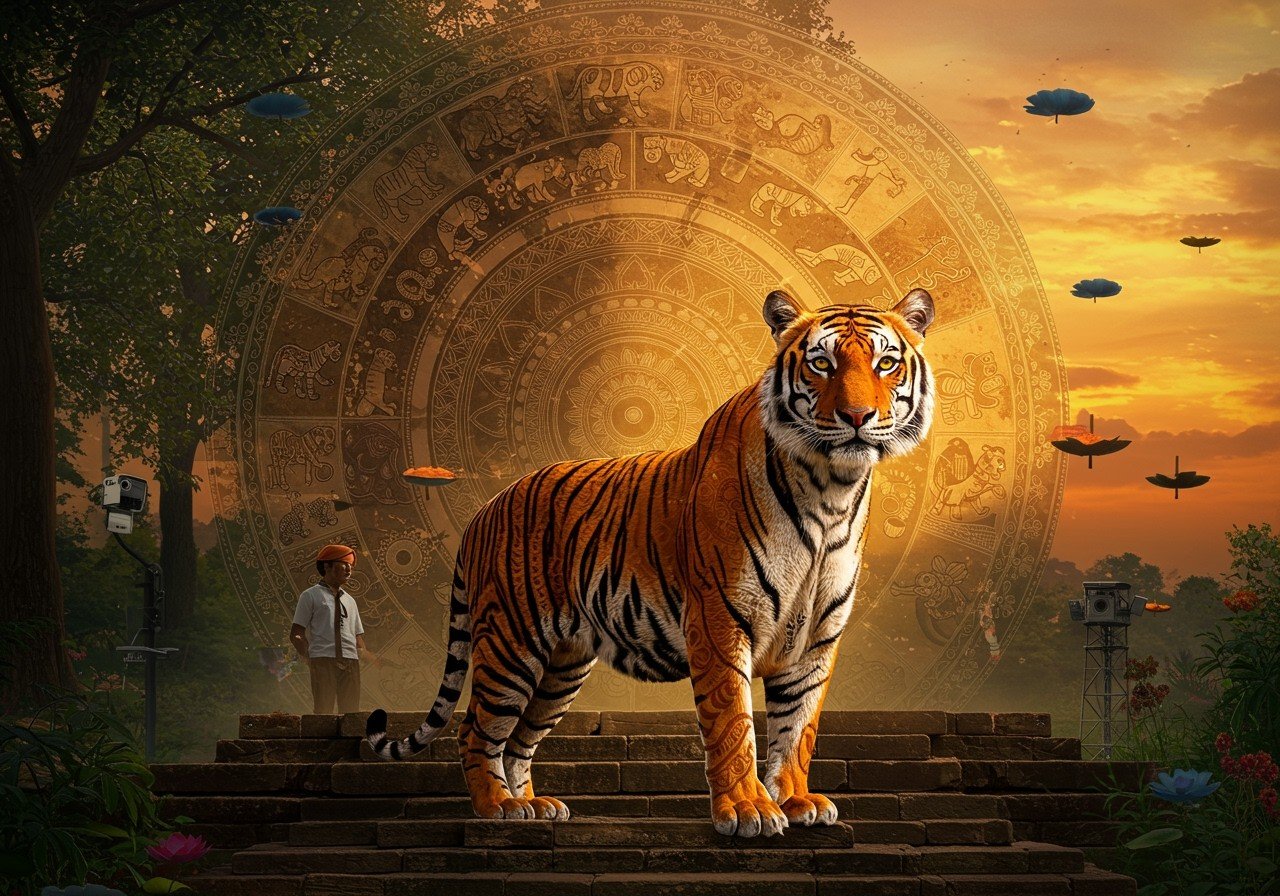
The Bengal Tiger, also known as Panthera tigris tigris, stands as an iconic symbol of power and grace. This magnificent creature holds a significant place in India’s cultural heritage and natural world. This blog delves into the historical evolution of the Bengal Tiger, its cultural importance, and the ongoing efforts to conserve this majestic species.
A Historical Overview of the Bengal Tiger
The Bengal Tiger’s lineage traces back millions of years, evolving from early members of the Panthera genus. Fossil evidence points to their presence in regions like India and Southeast Asia. Ancient Indian texts, including the Rigveda and Mahabharata, feature the Bengal Tiger, highlighting its cultural significance.
These majestic creatures were often depicted in temple carvings and paintings, showcasing their revered status. During the Mughal era, Bengal Tigers were even associated with royal courts, symbolizing prestige and power. Hunting practices in historical India often involved rituals and ceremonies centered around the tiger. Unfortunately, the British colonial period witnessed a decline in tiger populations due to sport hunting and habitat destruction.
The Bengal Tiger’s Cultural Significance
The Bengal Tiger is deeply intertwined with India’s rich cultural tapestry. It is not merely an animal but a symbol of national pride and heritage. In Indian mythology and religious beliefs, the tiger plays a significant role, often associated with deities like Maa Durga. Ancient Indian literature, such as the works of Kalidasa, features references to Bengal Tigers. They symbolize power and are integral to various Indian festivals and rituals, including Durga Puja.
Poojn.in recognizes the sacred connection between Maa Durga and the Bengal Tiger. We offer a wide selection of authentic puja items to honor this divine relationship. Enhance your Durga Puja experience with our collection of:
- Pure brass and copper Durga idols: Exquisitely crafted idols for your home altar or temple offerings. Find them here.
- Traditional Durga yantra: Enhance your spiritual practice with these sacred geometric designs. Explore our collection.
- Complete Durga puja samagri sets: Everything you need for a complete and authentic Durga Puja. Shop now.
Poojn.in ensures that all our products are crafted with utmost care and adhere to traditional specifications, making them perfect for your devotional needs.
Conservation Efforts and Triumphs
The Bengal Tiger has faced significant threats, including habitat loss, poaching, and human-wildlife conflict. However, dedicated conservation efforts have yielded positive results. Government initiatives like Project Tiger, launched in 1973, have played a crucial role in protecting tiger habitats and increasing their population.
The success stories of tiger population recovery in reserves like Ranthambore and Sundarbans are testaments to these conservation endeavors. Ranthambore’s lush forests and Sundarbans’ mangrove swamps provide ideal habitats for these magnificent creatures. The “Tx2” goal, set at the 2010 Tiger Summit, aims to double wild tiger numbers globally, reflecting a global commitment to tiger conservation. According to recent data, India’s tiger population has increased by over 65% since 2014, now harboring approximately 3,682 Bengal tigers, a remarkable achievement in conservation.
Challenges and the Path Forward
Despite the progress, challenges persist. Limited funding, political hurdles, and the ever-present threat of poaching continue to hinder conservation efforts. Community involvement and local support are essential for long-term success. International collaborations, such as those with WWF and CITES, provide crucial resources and expertise. Scientific research and technology, including camera traps and DNA analysis, play a vital role in monitoring tiger populations and informing conservation strategies.
Public Awareness and the Future of the Bengal Tiger
Raising public awareness is crucial for the Bengal Tiger’s survival. The tiger is not just a species; it is a cultural icon. Indian cinema, literature, and media play a significant role in shaping public perception. Social media campaigns and celebrity endorsements help amplify the message of conservation. Educational programs and responsible wildlife tourism foster appreciation for these magnificent creatures.
Non-profit organizations and NGOs actively advocate for tiger conservation, engaging communities and spreading awareness. Integrating traditional knowledge with modern scientific methods enhances conservation strategies. The Bengal Tiger’s journey exemplifies resilience and cultural significance. Supporting conservation through donations, volunteer work, or simply spreading awareness can make a tangible difference. Responsible tourism helps preserve tiger habitats while supporting local communities.
Conclusion: Securing the Legacy of the Bengal Tiger
The Bengal Tiger’s story is one of resilience, cultural significance, and ongoing conservation efforts. Continued research, collaboration, and sustainable practices are essential for ensuring its survival for generations to come. Let’s unite to protect India’s national treasure, the Royal Bengal Tiger, and ensure that its majestic roar continues to echo through India’s wild spaces.


